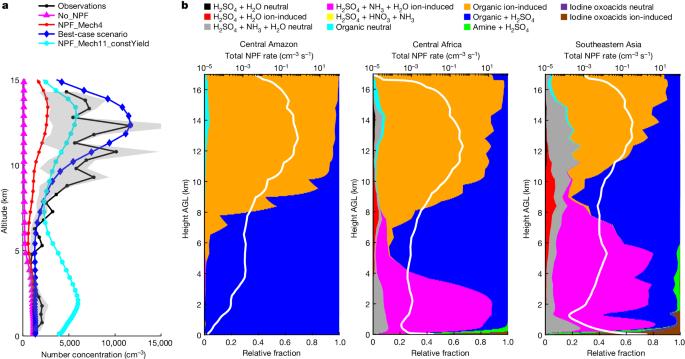insight - Computational Complexity - # Global Variability in Atmospheric New Particle Formation Mechanisms
Comprehensive Simulation of Global Atmospheric New Particle Formation Mechanisms and Their Impacts
Core Concepts
Comprehensive representations of 11 new particle formation mechanisms and their complex chemical transformations in a global climate model reveal distinct dominant mechanisms worldwide, with significant implications for aerosol pollution, climate change, and cloud formation.
Abstract
The article presents a comprehensive analysis of atmospheric new particle formation (NPF) mechanisms on a global scale. Key points:
- NPF is a critical process in understanding aerosol pollution and climate change, but the underlying mechanisms remain uncertain in most regions.
- The study developed representations of 11 NPF mechanisms and their chemical transformations in a global climate model.
- Simulations combined with observations show that the dominant NPF mechanisms vary significantly by region and altitude.
- Previously neglected or underrepresented mechanisms involving organics, amines, iodine oxoacids, and HNO3 are found to dominate NPF in many regions, including oceanic and polluted continental boundary layers, as well as the upper troposphere.
- These underrepresented mechanisms account for 10-80% of the nuclei on which clouds form at 0.5% supersaturation in the lower troposphere.
- Comprehensive simulation of global NPF mechanisms can improve estimation and source attribution of the climate effects of aerosols.
Customize Summary
Rewrite with AI
Generate Citations
Translate Source
To Another Language
Generate MindMap
from source content
Visit Source
www.nature.com
Global variability in atmospheric new particle formation mechanisms - Nature
Stats
New particle formation accounts for 10-80% of the nuclei on which clouds form at 0.5% supersaturation over various regions in the lower troposphere.
Quotes
"Previously neglected or underrepresented mechanisms involving organics, amines, iodine oxoacids and HNO3 probably dominate NPF in most regions with high concentrations of aerosols or large aerosol radiative forcing; such regions include oceanic and human-polluted continental boundary layers, as well as the upper troposphere over rainforests and Asian monsoon regions."
Key Insights Distilled From
by Bin Zhao,Nei... at www.nature.com 06-12-2024
https://www.nature.com/articles/s41586-024-07547-1
Deeper Inquiries
How do the identified dominant NPF mechanisms vary with factors such as latitude, longitude, altitude, and seasonal changes?
The identified dominant NPF mechanisms exhibit significant variations based on factors such as latitude, longitude, altitude, and seasonal changes. In terms of latitude, the mechanisms differ due to varying levels of solar radiation and temperature gradients. For instance, in high-latitude regions, nucleation involving iodine oxoacids and organics may play a more prominent role, while in low-latitude areas, amines and HNO3 could be more influential. Longitude also plays a role, with different sources of precursor gases contributing to NPF mechanisms in regions with distinct anthropogenic activities or natural emissions. Altitude is another crucial factor, as NPF mechanisms change with altitude due to variations in temperature, pressure, and the availability of precursor gases. Seasonal changes further impact NPF mechanisms, with different mechanisms prevailing during different seasons based on factors like temperature, humidity, and the presence of biogenic emissions.
What are the potential limitations or uncertainties in the comprehensive representations of NPF mechanisms developed in this study?
Despite the comprehensive representations of NPF mechanisms developed in this study, there are potential limitations and uncertainties that need to be acknowledged. One limitation is the complexity of atmospheric chemistry, which involves a wide range of precursor gases and intermediate compounds that interact in non-linear ways, making it challenging to capture all possible NPF pathways accurately. Uncertainties also arise from the spatial and temporal variability of atmospheric conditions, which may not be fully captured in global climate models. Additionally, the representation of aerosol-cloud interactions and feedback mechanisms introduces uncertainties, as these processes are highly complex and not yet fully understood. Moreover, the availability and quality of observational data for validating model simulations pose challenges in accurately assessing the performance of NPF mechanisms in global models.
How can the insights from this global analysis of NPF mechanisms be leveraged to improve climate models and our understanding of aerosol-cloud interactions?
The insights gained from this global analysis of NPF mechanisms can be leveraged to enhance climate models and deepen our understanding of aerosol-cloud interactions in several ways. By incorporating the identified dominant NPF mechanisms into climate models, researchers can improve the accuracy of aerosol predictions and their climate effects. Understanding the regional variations in NPF mechanisms can help refine model simulations, leading to more precise estimations of aerosol concentrations and their impacts on radiative forcing. Furthermore, insights from this analysis can guide future observational campaigns to focus on regions where underrepresented NPF mechanisms are prevalent, improving data collection and model validation. Overall, leveraging these insights can advance our knowledge of aerosol formation processes, leading to more robust climate models and better predictions of aerosol-cloud interactions.
0
